5Stimulus and Response
- 格式:pdf
- 大小:429.03 KB
- 文档页数:82
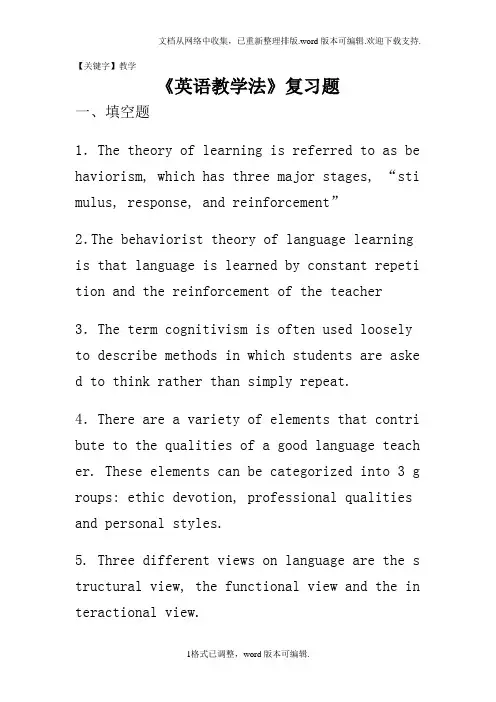
【关键字】教学《英语教学法》复习题一、填空题1.The theory of learning is referred to as be haviorism, which has three major stages, “sti mulus, response, and reinforcement”2.The behaviorist theory of language learning is that language is learned by constant repeti tion and the reinforcement of the teacher3.The term cognitivism is often used loosely to describe methods in which students are aske d to think rather than simply repeat.4.There are a variety of elements that contri bute to the qualities of a good language teach er. These elements can be categorized into 3 g roups: ethic devotion, professional qualities and personal styles.5. Three different views on language are the s tructural view, the functional view and the in teractional view.6. Language theories can be divided into two g roups:1)process-oriented theory 2)the conditio n-oriented theory7.The ultimate aim of foreign language teaching is to enable the learners to use the languag e in real life.8.The goal of CLT is to develop students’ com municative competence.municative competence includes knowledge of what to say, when, how, where, and to whom.10.The goal of CLT is to use language for comm unicative purpose11.The adoption of CLT is to develop learners’ language skills, namely, listening, speaking, reading and writing.12.CLT has not replaced the previous approache s or methodologies. It has only expanded the a reas: language content, learning process and l anguage product.13.Littlewood’s classification of communicati ve activities: Functional communicative activi ties and Social interaction activities.14. Language learning and teaching should be as close as possible to language USE IN REAL LIFE.15.Lesson planning should be done at two level s: Macro planning and Micro planning16.The first thing to do in lesson planning is to decide the aims of a lesson.17.The most popular teaching stages are three P’s model, which include: presentation, pract ice and production.18.Lesson planning means making decision in ad vance about what techniques, activities and ma terials used in class.19.There are four major principles behind good lesson planning: variety, flexibility, learna bility, and linkage.20.The aim of a lesson includes language point s to present, communicative skills to practic e, activities to conduct, and materials and te aching aids to be used.21.In the skill-oriented lessons, that is, ina reading or listening lesson, a 3-stage model is frequently adopted: pre-reading/listening, while-- reading/listening and post- reading/l istening.22.5-step model is more familiar to the middle school teachers: revision, presentation, dril l, practice and consolidation.23.Classroom management is the way teachers or ganize what goes on in the classroom.24.An instructor passes on knowledge by variet y of means.An organizer organizes the class so that learning activities can be carried out.25.A linguist named Harmer defined the teacher s’ roles as: controller, assessor, prompter,participant and resource provider.26.Ur reminds us not to hurt the students’ fe elings by: 1) Deal with it quietly; 2)Don’t t ake things personally; 3)Don’t use threats27.There are many different ways to teach a so und. It’s better to teach from Perception Pra ctice(认知) to Production Practice.28.One way to teach grammar is by 3P Model: Pr esentation,Practice and Production.29.The deductive method relies or reasoning, a nalyzing and comparing.30.In the inductive method, the teacher induce s the learners to realize grammar rules withou t any form of explicit explanation.31.Grammar practice is usually divided into tw o categories, Mechanical practice and Meaningf ul practice.32.By doing mechanical practice, the students pay repeated attention to a key element in a structure. Substitution and transformation dril ls are most frequently used in mechanical prac tice.33.Generally speaking, there are three stages in listening activities for language learners: 1.pre-listening 2.while-listening 3.post-list ening34.We will listen in two different ways: 1.Int ensive listening (for details) 2.Extensive lis tening (for general ideas)35.Listening in real life has the following ch aracteristics: Spontaneity, Listener’s respon se, Speaker’s adjustment, Context and Visual clues.36.Characteristics of successful speaking task s can be: 1.Maximum foreign talk 2.Even partic ipation 3.High motivation 4.Right language lev el37.The process approach focus on what studentsdo before /while /after their writing.38.Not everything can be purely communicative. Some writing activities can be between “writ ing for learning” and “writing for communica tion.39.The process of writing should be from contr olled to guided writing and to free writing40. Teaching reading in the classroom divides reading activities into basically three stages in which bottom-up and top-down techniques ar e integrate to help students in their reading comprehension and in increasing their language efficiency in general另附.Generally, lesson presenting mainly inclu des four aspects: Presenting teaching material s; Presenting teaching methods; Presenting lea rning strategies; Presenting teaching process二、简答题1.Why are people learning English?• They have to pass the examin ations.• They can help foreign visito rs.•It’s necessary if they want to enter university.• Learning a foreign language is an intellectual challenge.• They can use computers more easily.• They need to keep in touch w ith what is going on in their profession world wide.• English will be very importa nt to get a job in trade.• English will be useful for t hem to travel abroad.• They will be able to read and listen to in English. This can improve their knowledge of the world.2.What is language?Language is a means of communication with othe r people.3.What is the aim or purpose of language teac hing?Communication4.How many language teaching methods or appro aches do you know?l the grammar-translation methodl the direct methodl the audio-lingual methodl the situational language teachingl the cognitive approachl the silent wayl the total physical response methodl the communicative approachl the natural approachl the functional-notional method, etc. 5.How can you become a good language teacher?• Language training: a sound c ommand of English•Learn from others’ experien ce• Learn received knowledge, su ch as language theories, methodology, educatio n, psychology, etc.•Learn from one’s own experi ence• Practice makes perfect• Keep on reflecting on work, etc6.What is the challenge the language teacher is confronted with?People learn a foreign language1. For different reasons2. In different ways3. Having different understanding abou t language learning4. Having different capabilities in la nguage learning5. Different language levelsThus the challenge that the language teacher i s confronted with is how teaching methodology can cater for learners who have more differenc es than commonalities.7.What is the question that all approaches of language teaching should answer?The question is “What is language?”Language is a means of communication with othe r people.8.What are the three different views of langu age that language teaching and learning practi ce have been influenced by?They are the structural view, the functional v iew and the interactional view.9. How does the structural vi ew see language?• The structural view sees lan guage as a linguistic system made up of variou s subsystems. To learn a language means to lea rn these structural items so as to be able to understand and produce language.10.How does the functional view see language?• The functional view sees lan guage as a linguistic system but also as a mea ns for doing things. Learners learn a language in order to be able to do things with functional activities.11.How does the interactional view see langua ge• The interactional view consi ders language as a communicative tool, whose m ain use is to build up and maintain social rel ations between people. The learner has to stud y the patterns and rules of language above the sentence level to learn how language is used in different speech context.12. What are Process-oriented theories concerned with?How the mind processes new information13. What do Condition-oriented theories emphasize?The nature of the human and physical context i n which language learning takes place14.What is “pseudo practice”?It is a short period of time assigned for stud ent teachers to do teaching practice as part o f their education, usually under the supervisi on of their instructors.15. What does linguistic competence mea n?Competence simply means knowledge of the langu age system: grammatical knowledge in other wor ds.16. What does Communicative Competence mean?Not only the form of language, but also what t o say to whom and how to say it appropriately in any given situation. To be short, communica tive competence includes knowledge of what to say, when, how, where, and to whom.17. What is lesson planning?Lesson planning means making decisions in adva nce about what techniques, activities and materials will be used in the class.18. In how many ways do language teache rs benefit from proper lesson planning?l Make the teacher aware of the aims a nd language contents of the lessonl Help the teacher to distinguish the various stages of a lesson and to see the rela tionship between theml Think about how the students can be fully engaged in the lessonl Become aware of the teaching aids th at are neededl Think about the relative value of di fferent activitiesl Think about how much time should be spent on the activitiesl Judge lesson stages and phases with greater accuracyl Help to continue improvementl Add an evaluation to the planl Provide a useful, time-saving refere nce when the teacher next plans the same lesso n19. What factors influence a lesson?l 1.Physical conditions:l Class size: affects types of activit iesl Length of a lesson: determine how mu ch can be taughtl Size of classroom: restricts some ty pes of activitiesl Teaching aids: sufficient or notl Time of day: influences the types of activities used (p.m. or a.m.)l 2.Human factors:l different personalities of teachers decide different styles of teachingl varied needs and attitudes of studen tsl the students’ language levell the students’ learning backgroundl 3.Change (of )l The syllabusl Textbooksl The teaching system: meets the needs of the institutions and examinations20. What are the principles for good le sson planning?1)variety2)flexibility3)learnability4)linkage21. What does macro planning involve?Macro planning involves the following:a) Knowing about the courseb) Knowing about the institutionsc) Knowing about learnersd) Knowing about syllabus22. What does a lesson plan include?At least, it may have the following component s:l Teaching aimsl Language contents and skillsl Teaching stages and procedures23. What does the teaching aim of a les son include?l what language components to presentl what communicative skills to practic el what activities to conductl what materials to be usedl what teaching aids to be used24. What do language contents mean and what do language skills mean?l The former means: structures, gramma r, functions, topics and so onl The latter means: 4 communicative sk ills25. What is the difference between teac hing stages and teaching procedures?l Teaching stages are the major steps that language teachers go through in the class room. Procedures are the detailed steps in eac h teaching stage.26. What does a teacher need to consider when he/she has planned to present a new str ucture?l When to focus on the structure and w hen to study it in context;l Whether to present the structure ora lly or in written form;l When to give out information and whe n to elicit from students;l When and how to use visual aids to h elp with the presentation;l What to do if students fail to under stand.27. How can we manage a classroom effic iently?Only when three conditions are metl The teacher plays appropriate roles.l The students are grouped in a way suitable for the learning activities.l There is discipline and harmony in t he class.28. What factors may influence classroo m management?At least, the following factors are very impor tant for a classroom management:l People: the relationship between the teacher and the studentsl Language: what you expect them to do (understanding and encouraging students)l Environment: classroom, the position ing of the desks and the position of the teach erl Organization: good lesson plan, clea r learning objectives, variety in activities…l Tools: textbook, Ex-book, video-reco rder, a slide projector…29. What are the most common student gr ouping?l Lockstep/class/plenary, team work, g roup work, pair work, individual study30. How can we group the students?Some possible ways to group the students:l Group the students according to seat ing arrangement;l Students select their own group memb ers (risky);l Strong students and weak students ar e mixed together;l Strong students and weak students ar e grouped separately to do different tasks;l Group the students by drawing lots.31. What should be our realistic goals for teaching pronunciation?l Consistency: the pronunciation shoul d be smooth and natural.l Intelligibility: the pronunciation s hould be understandable to the listeners.l Communicative efficiency: the pronun ciation should help to convey the meaning that is intended by the speaker.32. What are the purposes of listening?1.Extract information from news, lectures, and instructions…2.Maintain social relations: Greetings, prais e, talk, gossip, chat…3.Be entertained: film, a joke, poem, and TV/r adio programs…33. How to speak oral English well?1.Listen to native speakers, talk about variou s topics .2.Learn useful idioms.3.Learn common words and phrases.4.Test your vocabulary skills in everyday Engl ish.5.Practice responding, in English, to real-life conversations.6.Listen to native speakers and give responses34. What are the factors that affect th e success of role-play ?1. the teacher’ enthusiasm2. careful instruction3. clear situation and roles4.making sure the students have the language they will need to carry out the role-play.35. Why do we read?1.survival, e.g. the label on a medicine bottl e.2.learning and information, e.g. newspapers, m agazines, books.3.entertainment or pleasure, e.g. novels, stor ies, poems as a leisure.36. What strategic skills do students n eed in order to make reading more efficien t?1.Skimming for main idea2.Scanning for specific information3.Inferring the meaning of unknown elements:lexical itemsattitude and opinionthe purpose of an articlerelevant information4.Recognizing rhetorical structure:chronological ordercomparison and contrastcause and effectreference指代5. Predicting: guessing what is coming next6. Distinguishing the main idea from supporting details37. Why do we write in English?l ExaminationWriting in English enables us to pass examinat ionsl CommunicationWriting in English is necessary in communicating with others.l EntertainmentWriting in English can be entertaining for us.38. What are the features of process wr iting(1) Focus on the process of writing that leads to the final written product.(2) Help students write to understand their ow n composing process.(3) Help them to build repertoires of strategi es for prewriting, drafting and rewriting.(4) Give students time to write and rewrite.(5) Please central importance on the process of revision.(6) Let students discover what they want to sa y as they write.(7) Give students feedback through out the com posing process (not just on the final product)to consider as they attempt to bring their ex pression closer and closer to intention.(8)Encourage feedback both from the instructor and peers.(9) Include individual conferences between tea cher and students during the process of compos ition.39. What can we benefit from communicat ive activities?• improve motivation (reason)•provide “whole-task practic e”• allow natural learning• create a context which suppo rts learning•三、判断正误1.A PERSON WHO HAS A GOOD COMMAND OF ENGLISH is not necessarily a good teacher because he/s he might have only one of the elements of prof essional competence.2.CLT has not replaced the previous approache s or methodologies.3.Communicative activities will help learners to develop their communicative competence.4. Proper lesson planning is essential for both novice and experienced teac hers.5. Unprepared teachers receiv e much less trust and cooperation from the stu dents.6. There are principles but n o standard way to plan lessons.7. Macro planning provides ge neral guidance for language teachers.8. Teaching stages are the major steps that language teachers go through in the classroom. Procedures are the detailed st eps in each teaching stage.9. Individual study is the st age during the class where the students are le ft to work on their own speed.10. Individualized learning is that the learners are given a measure of freedom to cho ose how and what they learn at any particular time.11. Punishment can never be our first c hoice to deal with bad-behaved students.12. Students need to be able to read an d write phonetic transcripts of words, in orde r to learn English.13. Poor pronunciation may cause proble ms for the learning of other skills.14. Stress and intonation are not impor tant for beginning learners15. Stress in pronunciation is sometime s as important as grammar16. Teachers should not encourage stude nts to improve their pronunciation as much as possible.17. The goal of English learning is pro bably to acquire near-native pronunciation.18. If the intonation is not appropriat e, it may convey the opposite meaning.19. Children do not learn grammar rules when they acquire their 1st language, so they don’t need them either when learning a foreig n language.20. Students need to be given detailed grammar rules if they want to learn a foreign language successfully.21. Teaching and learning grammar shoul d focus on practice rather than the study of g rammar itself.22.Knowing grammar isn’t enough for r eal communication.23. Grammar should be taught and prac ticed in context.24. The more language the learners ar e exposed to or produce, the more they are lik ely to learn.25. Practice should be able to elicit different sentences and generate different lev els of answers from different learners.26. Avoid different grammatical termi nology as much as possible.27. Do not be frustrated by the stude nts’ mistakes and errors, wh ich are inevitabl e in language learning.28.It is students’ own business to recite the words and phrases.29. Language consist of word with equivalents from one language to another30. Vocabulary cannot be taught, it mus t be learned by the individuals.31. The best way to explain vocabulary is to translate.32. Words can be taught and learned mos t effectively in groups of words which are rel ated to each other in meaning.33. Words must be learned in language contexts34. Not all words are equally importa nt35. If writing tasks focus on the produ ct rather than on the process, they do not hel p students to develop real writing skills.36. It is helpful use a dictionary to find the meaning of all new word37. Reading has only one purpose. i.e.to get information.38. When reading in a foreign language, we mentally translate everything in order to u nderstand.39. The lack of cultural knowledge may affect the rate of reading comprehension40. Teachers should help the students t o read on their own四、案例分析(例)1.Two teachers presented the word “grumble”. Below are the descriptions of how they did i t. Which way is more effective. Try to give re asons for your decision.Teacher A: a) wrote “grumble” on the blackbo ardb) Said “complain about some one or something in an annoyed way”.c) Translated the word into the students’ native language.d) Gave more example sentence s for the students to translate into their nat ive language.Teacher B: said “so me people grumble about ev erything. For example, they grumble about the weather. If it is sunny, they say it is too ho t. If it is cool, they say it is too cold. The y are never happy with the weather”. They alw ays grumble about the weather. Then the teache r set out to check the student’s understandin g by asking what does ‘grumble’ mean?”2.Read through the following writing activiti es and decide which activities are writing for consolidating language, and which are writing for communication. Try to give reasons for yo ur decision.Activity 1Join the pairs of sentences, using when/where. Example:Kentucky is the state. Lincoln was born there. Kentucky is the state where Lincoln was born.• This book is about the time. Lincoln was President then.• The school is still standin g. Lincoln learnt to read and write there.• There were many poor people in the town. Lincoln grew up there.• Lincoln had very little free time. He could study then.Activity 1 is obviously “writing for c onsolid ating language”.Activity 2Letter WritingDo you think any of the courses (math, physic s, English, history, etc.) you are talking now can be improved in some way. If yes, write a short letter to the teacher and present your s uggestions.Activity 2 can involve true communication五、教学活动设计(例)1.How do we evaluate whether language teachin g activities are communicative or not?Ellis has listed six criteria for evaluating:• communicative classroom acti vities:• communicative purpose: infor mation gap• communicative desire: a real need• content, not form: on what,not how• variety of language: not jus t one specific language form• no teacher intervention: for the purpose of communication, not for the acc uracy of language•no material control: Ss’ ch oiceDesign an activity that may meet some of the c riteria. The activity may only include the dir ections, contents and procedures2. Suppose you are going to teach the structure “used to do” in a deductive method. How wo uld you do it? Design a mini lesson plan in wh ich only the teaching steps must be made clea r.3. What techniques or combination of technique s you would use to present the following vocab ulary items. Design a mini lesson plan in which only the teaching steps must be made clear.two million a reward love fight4. Use transition devices to design a while-re ading activity for the following text.Rosa Morello is from Columbia in South Americ a. She is a student. She has come to London to study English. Rosa is eighteen years old and single. She has dark hair; dark brown eyes an d is 1.65 m tall. She likes pop music, dancin g, reading and good food. She is also interest ed in travel and languages. In London, Rosa li ves in a small flat with her friend Linda Morr is. The flat is in north London.六、教案撰写(略)此文档是由网络收集并进行重新排版整理.word可编辑版本!。
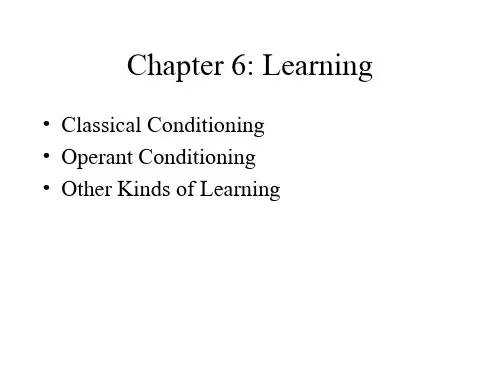


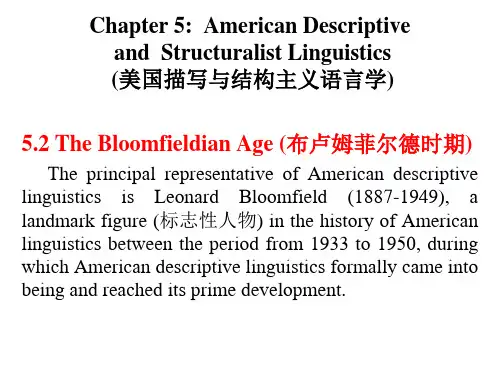
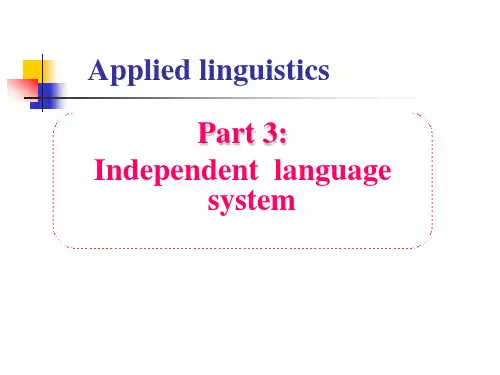
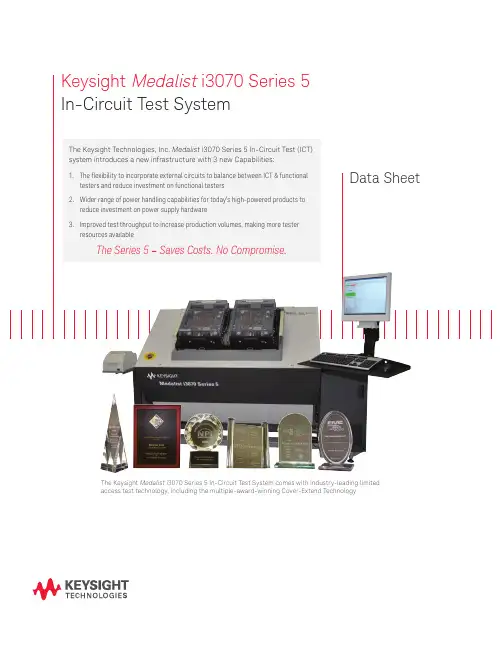
Keysight Medalist i3070 Series 5 In‑Circuit Test SystemData SheetThe Series 5 – Saves Costs. No Compromise.The Keysight Technologies, Inc. Medalist i3070 Series 5 In‑Circuit Test (ICT) system introduces a new infrastructure with 3 new Capabilities:1. The flexibility to incorporate external circuits to balance between ICT & functional testers and reduce investment on functional testers2. Wider range of power handling capabilities for today’s high-powered products to reduce investment on power supply hardware3. Improved test throughput to increase production volumes, making more tester resources availableThe Keysight Medalist i3070 Series 5 In‑Circuit Test System comes with industry‑leading limited access test technology, including the multiple‑award‑winning Cover‑Extend Technology.Latest Features on the Series 5 ICT SystemNew Analog Measurement CardThe new Analog Stimulus and Response Unit (ASRU) includes 1. BT-Basic DLL IntegrationThis feature allows users to call any external DLL function by pass‑ing the parameters and receiving the results within the BT‑Basic environment. Examples of DLL functions include flash program‑ming, updating of databases and functional tests.2. Keysight Medalist i3070 LED Test* Medalist i3070 LED Test is an industry‑first digital LED test, integrated into ICT, to inspect the color and intensity of LEDs in the visible light spectrum (400‑660 nm). It provides fast, reliable, and accurate inspection of LEDs for color (wavelength) and luminosity (intensity).3. Two channels of high current capabili-ties of up to 10 A per channel The DUT power supply channels 3 and 4 on the ASRU card have their current capabilities increased from 4 A to 10 A per channel. This allows the channels to carry 10 A currents into the board for high current application testing, such as power supplies.4. Power Monitoring CircuitThe Power Monitoring Circuit (PMC) is a new safety feature. It not only provides real timemonitoring but also helps users to distinguish between a power sup‑ply failure or a digital test failure in the event of a failed digital test. This feature also tries to prevent the back‑drive current that can cause damage to ICs. 5. Fixture power supply This powering capability is intended for fixture electronics andother external powering purposes.Figure 1. The new analog stimulus and response unit card in the Medalist i3070 Series 5 offers users many new features and faster analog testsIt is controlled by the user with BT‑BASIC commands for enabling and disabling.6. 60 V zener testing capabilities In today’s boards, because of their higher voltage power supply requirements, larger zener diodes are required. With the new ASRU card, a maximum of 60 V zeners can be tested instead of up to 18 V.7. Digitized Measurement Circuit (DMC) with new frequency options The purpose of this circuit is to speed up the analog testing by using multiple ports on a micro‑controller to digitize, at one time, the multiple readings taken during a test. The microcontroller ports can be assigned to the stimulus and response busses as well as the sense busses, so that all fourreadings on a 4‑wire measurement can be taken at one time. This Digitized Measurement Circuit comes with two new frequency options: fr100k and fr200k. These frequencies are added to the AC testing methods for passive components like capacitors and inductors for better isolation of smaller components during test.This new measurement circuit is different and separate from the analog measurement circuit using Measurement Op‑Amplifier (MOA). Tests generated for the MOA will have to be re‑debugged if tested with the DMC because the internal circuit characteristics are different from the MOA. The stability and reliability of the measurement after the test has been debugged remains the same as whenmeasured with the MOA circuit.* (Appropriate hardware is needed)Latest Features on the Series 5 ICT SystemIncorporating External ElectronicsThis capability is enabled through both hardware and software features added to the i3070 Series 5 test system.Introduction of utility cardThe new utility card is an optional pin card that will fit in a card slot in any of the modules on the testhead. It has three cavities in the card to allow users to plug in their own custom electronics for added functional test or functionality during ICT. The user can now design his own card and make it part of the tester. One utility card can be installed on each module. Each custom electronics unit should come with the necessary software drivers that can be installed on the testhead controller.Each cavity on the utility card has two connectors; one is mainly for a signal bus to the board under test and the other for power and control to the external electronics installed in the cavity.Please refer to the Keysight data sheet 5990‑4411EN (Keysight Utility Card Specifications) for more detailson the utility card.Figure 2. The new utility card on the Medalist i3070 Series 5 allows for customizable functional tests to be added at the in‑circuit test processConnecting external instru‑ments or equipmentBalanced multiplexed 1:4 75 Ω portsTwo balanced 1:4 multiplexed 75 Ω ports are available on the utility card to allow users to add differentialsignals to the board under test. These ports can be used individually for single sided signals.Parameter Rating Number of ports 2Multiplexing 1:4Bandwidth 3 dB(at 35 MHz ±3 MHz)Crosstalk < 1 MHz(–55 dB ±2 dB)Maximum current 2 A ±0.5 A Impedance75 Ω per pairGeneral purpose relaysEight general purpose relays are available on the utility card. The control of these relays in software is the same as for the general purpose relays on the ASRU.Flexible 1:6 multiplexed power supply channelsThe Utility Card allows 48 V at 10 A on each of two 1:6 port power supply channels. Each power supply channel can be user‑configured to be multiplexed to supply power to up to six individual boards on a panel or the individual relays can be configured to switch together to enable testing of a single board which requires 10 A current power supplies.Latest Features on the Series 5 ICT System Software EnhancementThe Series 5 also includes softwareand enhancements listed below, andretains all the user‑friendly featuresof the original i3070 system, such as:–DC test method for largecapacitor testingWhen testing large capacitors, itis possible to specify the currentinstead of using the standard100 mV across the capacitor.–Ease of usePoint‑and‑click interfacesremove the user’s need to type incommands during the operationof the tester–Board LocatorThe Board Locator allows theuser to search for any componenton the board under test aswell as probes and testheadresources.–AutoOptimizerKeysight Medalist i3070 testscan be optimized with the clickof a button, reducing test time by10 to 50 percent per test.–AutoDebugWith the click of a button, thesystem can perform a completeanalog test debug in a matterof hours. AutoDebug fine‑tunestests so boards pass reliably inproduction.Please refer to the Keysight Medalist i3070 In-Circuit Test System data sheet 5989‑6292EN for detailed informa‑tion on the original features which users can continue to enjoy on the Series 5.Figure 3. The Series 5 retains all the easy‑to‑use interfaces that many users are now accustomed to on the Medalist i3070 systemRelated Keysight LiteratureKeysight Medalist i3070 Series 5 Multiplexed Keysight Medalist i3070 Series 5 Un-multiplexedMaximum channels11525184Maximum nodes51845184Pin card HybridPlus double density Un-multiplexed hybrid 144 channel Driver/receiver mux ratio9:2 multiplexing1:1 tester-per-pinVector application rate 6.25 MPs, 12.5 MPs, 20 MPs 6.25 MPsLogic level–3.5 V to 5 V(per digital channel pin programmable)0 to 4.75 V(per-pin programmable)Logic threshold Dual threshold Single thresholdSlew rate25 V/µsec to 275 V/µsec(per digital channel pin programmable)300 V/µsec (optimized fixed rise/fall time)Digital driver/Receiver offset–30 n to +100 n(per digital channel pin programmable)Not applicableOperating system Windows 7 ProfessionalTest generation toolset Board ConsultantFixture ConsultantTest ConsultantTime-to-money test developmentBoard/Fixture graphics display BrowserBoard ConsultantFixture consultantBrowserCircuit analysis Automatic (IPG) with Monte Carlo simulationKeysight Medalist i3070 ApplicationSoftwareWindows graphical user interface (supports localization)Probe pin locator Interactive probe/pin locator with guided probedRuntime yield display Real time FPY (First Pass Yield) display at runtimeProbe/fixture maintenance tools Worst probe reporting (reports real time fixture probe number that fails frequently) Yield enhancement tool IYET (Intelligent Yield Enhancement Tool)Analog unpowered debug interface Graphical user interface in spread sheet format (supports localization) Digital/Analog powered debug interface PushButton DebugAutoDebug AutoDebug on analog unpowered tests, TestJet, VTEP v2.0 (VTEP, iVTEP and NPM) andCover-Extend TechnologyModular construction forflexibility/scalability(1 to 4) StandardDual-well construction for maximumthroughputStandardThroughput multiplier StandardFailure message printer Standard (strip printer)Vacuum solenoids Built-in standardKeysight Medalist i3070 Series 5 Multiplexed Keysight Medalist i3070 Series 5 Un-multiplexedSystem power input connections Included (power supply type will be specified based on regional requirements) Shipping and installation assistance Included (Keysight authorized representative)Analog unpowered measurement 2 to 6 wire measurementBackdriving current750 mABackdriving test program setup Automatic by logic familyOvervoltage protection YesCapacitor discharge protection YesArbitrary waveform generator YesFixture types supported Short wire, long wireRepeatability ExcellentTransportability ExcellentTemperature compensation AutoAdjust at every 5° C temperature drift/1000 hours of operation Open/short testing Yes (automatic IPG)Analog testing Yes (automatic IPG)Vector programming VCL and PCFVectorless testing VTEP v2.0 and TestJetNAND tree program generator Language basedDisabling analysis Yes (automatic IPG)Digital test pattern generator YesFrequency measurement60 MHz (beyond 60 MHz measurement possible using fixture electronics solution) Multilevel disable (digital isolation)YesHigh-voltage testing capability 100 VLow-voltage testing capability No limitNumber of analog guarding points UnlimitedWorst probe report YesFirst pass yield report YesComponent-level coverage report YesIntelligent yield enhancement test YesLimited access tools YesFlash 70 device programming YesPolarity check software YesICT Boundary Scan YesPanelTest for panelized PCBAs YesSimplate express fixturing software YesStandard i3070 operating system YesMultiple board versions software YesDual-well sharing YesThroughput multiplier YesRelay-level diagnostics tool Included1-year licenseSPC quality tool Push-button Q-Stats(stand alone)Drive thru Dual-well sharingFlash programmingFlash ISP PLD ISPAdvanced probe spacing VTEP v2.0 PoweredVTEPiVTEPNPMCover-Extend TechnologyTestJet InterconnectPlusBoundary Scan Advanced Boundary Scan 1149.6Polarity check Throughput multiplierSilicon nails Panel testFlash70InterconnectPlus Boundary Scan Advanced Boundary Scan tool suiteDrive-Thru for VTEP v2.0Test development software for Vectorless Test Extended Performance (VTEP) tool TestSight Developer CAD translation software for ICT test and fixture developmentFlash ISP In-system programming for flash memory devicesISP suite Combined flash and PLD in-system programming software suiteSilicon nails Test development tools for limited access test coverageCover-Extend A hybrid of Boundary Scan and VTEP testing for added test coverage on limited test accessboardsN/AConnect Check Analog testing in a limited accessenvironmentAnalog capabilitiesShorts and Opens 2 Ω – 1000 Ω ± (0.25% + 2.2 Ω)Resistors 0.1 Ω to 10 MΩ ± (0.25% to 5% + plus system residual ≤ 3.5 W) Capacitors10 pf to 10 mf ± (2% to 6% + *)* Plus system residual: ± 1 pF with capacitor compensation,0 to +40 pF typical without capacitor compensationInductors 5 μH to 100 H ± (2% to 5%) + plus system residual: 1 μH Potentiometer Same method as resistorsDiode± 0 – 19 V ± (1.0% of reading + 4 mV) + plus system residual: ≤ 3.5 mV/mA Zener± 0 – 18 V ± (1.0% of reading + 4 mV) + plus system residual: ≤ 3.5 mV/mA8± 19 – 60 V ± (1.0% of reading + 4 mV) + plus system residual: ≤ 3.5 mV/mA8 Transistor Same method as Diode + DC Beta (10-1000 ± (15.0%))Depletion FET 5 Ω – 500 Ω ± 1.0% + plus system residual ≤ 3.5 WFuse, switch, jumper0.1 Ω – 500 Ω ± 1.0% + plus system residual ≤ 3.5 WControl card Control XTPNumber of modules supported 1 to 4 modules (additional modules activation package to expand capabilities of systemshaving unused empty modules. Required additional hybrid card, Control XTP, ASRU cardand associated cabling and hardware)DUT power suppliesDUT power supplies type*Keysight PS6751Quad Output (0-50 V/0-5 A)Keysight 6624 Quad Output (0-20 V/0-2 A, 0-7 V/0-5 A, 0-50.5 V/0.0824 A, 0-20.2 V/0-2.06 A)Keysight 6621A Dual Output (0-7 V/0-10 A, 0-20.2 V/0-4.12 A)Keysight 6634 Single Output (0-100 V/0-1 A)Keysight 6642 Single Output (0-20 V/ 0-10 A)Number of supply channels Up to 24 programmable supplies or up to 32 channel with utility card AccessoriesBar code reader For data entry of DUT board serial numberPin verification fixture For system calibration and diagnosticsPerformance port To add external signal capabilities to your i3070 systemProduct support kits Multiple optional kits to choose fromConsulting services Multiple service options and products to choose fromUser training Multiple optional training programs to choose from* Refer to Keysight Medalist i3070 Series 5 Test Method and Specifications for more detailsAdditional information on Keysight’s Medalist In‑Circuit Test Solutions can be found at /find/ict/find/ict /find/i307009 | Keysight | Medalist i3070 Series 5 In‑Circuit Test System ‑ Data SheetThis information is subject to change without notice.© Keysight Technologies, 2017Published in USA, December 2, 20175990‑4344ENFor more information on KeysightTechnologies’ products, applications or services, please contact your local Keysight office. The complete list is available at:/find/contactus Americas Canada (877) 894 4414Brazil 55 11 3351 7010Mexico001 800 254 2440United States (800) 829 4444Asia Pacific Australia 1 800 629 485China800 810 0189Hong Kong 800 938 693India 1 800 11 2626Japan 0120 (421) 345Korea 080 769 0800Malaysia 1 800 888 848Singapore 180****8100Taiwan0800 047 866Other AP Countries (65) 6375 8100Europe & Middle East Austria 0800 001122Belgium 0800 58580Finland 0800 523252France 0805 980333Germany ***********Ireland 1800 832700Israel 1 809 343051Italy800 599100Luxembourg +32 800 58580Netherlands 0800 0233200Russia 8800 5009286Spain 800 000154Sweden 0200 882255Switzerland0800 805353Opt. 1 (DE)Opt. 2 (FR)Opt. 3 (IT)United Kingdom0800 0260637For other unlisted countries:/find/contactus (BP‑9‑7‑17)/go/quality Keysight Technologies, Inc.DEKRA Certified ISO 9001:2015Quality Management SystemEvolving Since 1939Our unique combination of hardware, software, services, and people can help you reach your next breakthrough. We are unlocking the future of technology. From Hewlett-Packard to Agilent to Keysight.myKeysight/find/mykeysightA personalized view into the information most relevant to you. /find/emt_product_registrationRegister your products to get up‑to‑date product information and find warranty information.Keysight Services/find/serviceKeysight Services can help from acquisition to renewal across your instrument’s lifecycle. Our comprehensive service offerings—one‑stop calibration, repair, asset management, technology refresh, consulting, training and more—helps you improve product quality and lower costs.Keysight Assurance Plans/find/AssurancePlansUp to ten years of protection and no budgetary surprises to ensure your instruments are operating to specification, so you can rely on accurate measurements.Keysight Channel Partners/find/channelpartnersGet the best of both worlds: Keysight’s measurement expertise and product breadth, combined with channel partner convenience.。
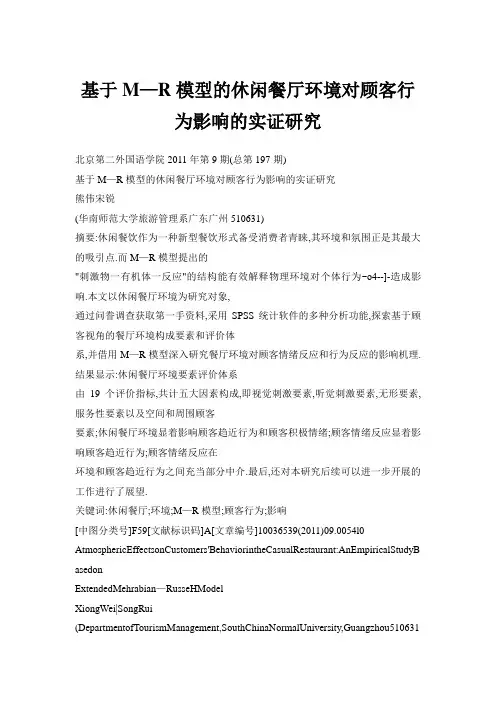
基于M—R模型的休闲餐厅环境对顾客行为影响的实证研究北京第二外国语学院2011年第9期(总第197期)基于M—R模型的休闲餐厅环境对顾客行为影响的实证研究熊伟宋锐(华南师范大学旅游管理系广东广州510631)摘要:休闲餐饮作为一种新型餐饮形式备受消费者青睐,其环境和氛围正是其最大的吸引点.而M—R模型提出的"刺激物一有机体一反应"的结构能有效解释物理环境对个体行为~o4--]-造成影响.本文以休闲餐厅环境为研究对象,通过问誊调查获取第一手资料,采用SPSS统计软件的多种分析功能,探索基于顾客视角的餐厅环境构成要素和评价体系,并借用M—R模型深入研究餐厅环境对顾客情绪反应和行为反应的影响机理.结果显示:休闲餐厅环境要素评价体系由19个评价指标,共计五大因素构成,即视觉刺激要素,听觉刺激要素,无形要素,服务性要素以及空间和周围顾客要素;休闲餐厅环境显着影响顾客趋近行为和顾客积极情绪;顾客情绪反应显着影响顾客趋近行为;顾客情绪反应在环境和顾客趋近行为之间充当部分中介.最后,还对本研究后续可以进一步开展的工作进行了展望.关键词:休闲餐厅;环境;M—R模型;顾客行为;影响[中图分类号]F59[文献标识码]A[文章编号]10036539(2011)09.0054l0 AtmosphericEffectsonCustomers'BehaviorintheCasualRestaurant:AnEmpiricalStudyB asedonExtendedMehrabian—RusseHModelXiongWei|SongRui(DepartmentofTourismManagement,SouthChinaNormalUniversity,Guangzhou510631,China)Abstract:Asonekindofthemostpopulardiningstyles,thenew—fashionedCasualDiningattractstonsofcustomersbyitsenvironment andatmosphere.Moreover.M—Rmodelrevealsthestructureof"Stimulus—Organism—Response"whichCalleffectivelyexplainhowtheatmo—sphericsleadstothebehaviorsThemainpurposeofthisstudyistoexaminethemeasurements ystemoftheCasualRestaurantsconsumption environmentfromtheperspectivesofcustomersandtheroleofCasualRestaurants'consumpt ionenvironmentoncustomers'emotionalresponsesandbehaviors.DatawerecollectedusingaquestionnairesurveyandwereanalyzedviaSPSS1 6.0.Thefindingsareshowedasfollowings:The restaurantsenvironmentcomprisestotally19factorsinto5dimensionsconsistingofvisualsti mulus,auditorystimulus,intangibles,servers, congestiondegreeandothercustomers.Restaurantsenvironmentaffectsbothcustomers'ad ventbehaviorandpositiveemotionsignificantly. Emotionalresponsealsoinfluencescustomers'adventbehaviorobviousEmotionalrespons eplaysasthemediatebetweenrestaurantsenviron- meritandadventbehavioeFinally,somesuggestionsforfollow-upresearchareputforward. Keywords:casualrestaurants;consumptionenvironment;M—Rmodel;customers'behavior;effect.一,引言近年来,休闲餐厅作为一种新型餐饮形式已成为顾客用餐之余的休闲场所,赢得了众多消费者的青睐.而其环境与氛围是吸引顾客前往消费的最大亮点,根据餐厅的不同定位,其环境渲染的氛围可以是中式的,西洋的,古典的,现代的等,感受可以是热烈刺激,新奇动感或者优雅浪漫,休闲适度等.然而,烘托和渲染休闲餐厅的[基金项目]广东省哲学社会科学规划项目(09GO一09);广东省自然科学基金自由申请项目(10151052101000008);广东省自然科学基金博士启动项目(9451063101002226).[收稿日期]2011—04~13[作者简介]熊伟(1981~),女,湖南长沙人,硕士,华南师范大学旅游管理系讲师,主要研究方向为酒店管理与会展研究.宋锐(1987~),男,广东东莞人,华南师范大学旅游管理系2006级学生,研究方向为旅游管理.54北京第二外国语学院2011年第9期(总第197期)氛围并不是靠单纯的某个指标可以达到的,其具体由哪些要素构成值得研究.环境行:勾学研究表明,环境会对顾客的行为意向产生影响.餐厅的环境,例如空问布局,设备,灯光以及员工形象等,会在一定程度上影响顾客的情绪(积极或者消极),最终会影响顾客的行为反应(趋近或者回避)】.在实践中,如果能明确其影响机制,将有助于餐厅有针对性地采取相关措施,以提高顾客满意度.因此,本文从顾客角度出发,通过实证研究探讨现实的休闲餐厅环境对顾客情绪和行为的影响,从理论上深入解释休闲餐厅环境对顾客情绪和消费行为的作用原理,以期为休闲餐厅经营和管理提供决策参考.二,国内外研究现状1.概念界定当百胜集团名下的必胜客用比萨饼为先导将休闲餐饮引入中国大陆之后,以休闲为主要目的的餐吧,酒吧,茶艺馆等休闲餐饮形式迅速发展起来】.休闲餐厅的定义有广义和狭义之分,其广义定义较为普遍,即包含主要的休闲餐饮形式.而狭义定义具体指以"休闲,舒适,情趣,品味"为主题的休闲餐厅,咖啡馆,酒吧,餐吧,茶艺馆等各种风格不同的休闲餐饮样式p.环境与氛围是休闲餐厅的主要特点,也是其最大的卖点.休闲餐厅的顾客消费动机不再是单纯的吃饭,而更多的是实现其交友,休闲,商务,家人团聚等诸多功能.因此,在选择这类餐厅就餐时,人们通常会将环境放在第一位,其中,作为硬环境的装修和作为软环境的文化活动显得相当重要.2.M—R,溪型莫拉比安一罗素模型(Mehrabian—Russell Model,简称M.R模型),是由两位环境心理学家Mehrabian5阳Russell于1974年提出来的,用于解释物理环境对人类个体行为的影响.模型中论证了一个Stimulus—Organism-Response(简称s一0一R)的结构(图1),即"刺激物一有机体一反应"的结构.这个结构说明外部环境的刺激(s)可以导致一个人产生情绪的反应(O),这个情绪反应进而引出人对于环境的趋近或者回避行为(R).在此模型中,情绪反应是环境刺激和个体行为关系的中介【".图1MR模型结构资料来源:Mehrabian—Russell(1974),AnApproachto EnvironmentalPsychology.M.R模型中的测量主要集中在两方面,一是测量人们对物理环境的情绪反应,二是测量这种情绪反应产生的行为变化.针对环境的刺激,人们对环境信号的情绪反应可划分为3个维度,即PAD:愉悦水平(pleasure),激励水平(arousa1)和控制水平(dominance).这3种不同情绪组合导致了不同的行为结果,这些行为用趋避行为(approachandavoidance)来衡量[1】. M—R模型早期主要应用于环境心理学的范畴中,随后被广泛应用在百货零售行业[4】,电子商务,酒店业,社会服务和银行业嘲等领域,但国内关于M—R模型在餐饮行业的研究则相对缺乏.3.环境要素的构成MR模型中只提到了环境要素(atmospherics)的概念,并没有对环境要素的变量建立明确的分类.之后,学者们在MR模型的基础上,针对不同领域,研究出了环境要素的具体细分内容,得出了有关环境要素变量分类的重要结论[9钔.总体而言,餐饮业的环境可分为4部分,即内部装饰,气氛,空间布局和人为因素n.而社会陛的因素(如好的雇员)包含在其中,会使得服务质量的影响和环境的影响两者难以区分.因此,在服务行业中,环境要素应被限制在物理环境中,不包括在社会性环境中.人为因素应该仅仅包含员工中不变的因素(如员工的外观和视觉性),但不包含其行为(如问候和服务).4.顾客情绪反应的构成在M—R模型中,顾客消费情绪的测量是用PAD测度来进行的.然而,PAD测量方法无法覆盖情绪的全部领域,研究者无法确定具体的情55北京第二外国语学院2011年第9期(总第197期) 绪.另外,这个方法用了两极化的项目,无法捕捉积极和消极情绪的同时存在.近年来,以消费情绪为自变量的顾客研究中,所使用的情绪量表和消费情绪结构绝大部分是以积极情绪和消极情绪为分类标准的.其中,积极情绪包括满意的,乐观的,受鼓舞的,充满希望的,快乐的,愉悦的,放松的,兴奋的等,消极情绪包括生气的,受挫的,紧张的,担心的,沮丧的,尴尬的,受羞辱的,束手无策的等.而且,积极睛绪会导致趋近行为(停留较长时间,正面口碑等),消极情绪会导致回避行为(停留较短时间,负面口碑等).因此,情绪按照正面和负面进行分类更优于PAD模式,结合积极情绪和消极情绪,可得到顾客整体态度倾向.5.顾客行为反应的构成在MR模型中,顾客行为反应即趋近与回避此环境的意愿,称之为趋避行为].趋近行为是向前移动进入一个环境,在其中停留,探索,互动及认同,表现良好,且有再回到该环境的意愿;回避行为则相反,表现变化,且有不满,焦虑,无聊及暴躁,希望离开该环境,没有再返回的意愿.其反应依环境所引发的程度而定,用以预测消费者情绪及其对环境的反应].趋避行为包括4个层面:一是顾客想要停留(趋近)或是离开(回避)所身处的实体环境;二是顾客自发性地想要在实体环境中随处浏览, 观看(趋近)或是顾客具有避免移动,和环境接触(回避)的倾向;三是顾客自愿地想和实体环境中的其他人进行沟通(趋近)或是避免和环境中的其他人互动,忽略和他人沟通(回避)的倾向;四是任务结果在绩效和满意上的提升程度'].而这4个层面的趋避行为可对应在餐厅的实体环境中得到衡量:第一,顾客是否推荐或再次光顾该餐厅;第二,顾客在用餐时是否注意到餐厅的装潢布置;第三,顾客是否愿意和员工互动沟通;第四,顾客惠顾该餐厅的频率,在餐厅的用餐时间,花费的金额等.综上所述,基于M.R模型进行休闲餐厅环境对顾客行为影响的实证研究具有充分的理论基础,科学可行,并能在一定程度上丰富有关餐饮研究和旅游者消费行为的内容体系.56三,研究设计本文拟以M—R模型为理论基础,以休闲餐厅为研究主体,以餐厅顾客为研究对象,以休闲餐厅的环境作为刺激物,来探讨休闲餐厅环境如何对顾客的情绪反应产生作用,并影响顾客的消费意愿和行为.1.研究方法本研究综合运用了文献研究法,实地研究法,调查研究法,统计分析法等多种研究方法. (1)文献研究法.本研究主要通过Elsevier数据库(www.seieneedirect.corn),中国期刊网以及中文期刊数据库(维普)等途径搜索国内外相关文献,将其作为本研究的理论基础;(2)实地研究法.在问卷设计的前期阶段,笔者于20010年2月1日至3月1日期间分别到广州市的12家休闲餐厅进行了实地考察,对其环境进行了深入细致的观察和详细记录,以为问卷设计和相关分析提供依据;(3)调查研究法和统计分析法.在实证研究中,为了保证样本的随机性和有效性,并能获得足够有效的样本量,本研究采用户外发放和网络平台发放相结合的方式发放调查问卷,并运用SPSS16.0统计软件对数据进行定量分析.2.模型构建本研究以M.R模型为基础,证明s—O—R理论结构在餐饮行业的应用性.并探讨在休闲餐厅中,环境是如何影响顾客的情绪反应和消费行为的.本文的研究模型如图2所示.一叵餐厅消费环境背景要素设计要素社交要素顾客行为反应趋近行为【刨避行为图2本研究理论模型3.问卷设计问卷分四大部分,前3部分是对餐厅环境,北京第二外国语学院2011年第9期(总第197期) 顾客情绪反应和顾客行为意向的测度,全部条款采用李克特5.点量表(Likertscale)("1"为非常不同意,"5"为非常同意,l~5分别表示认同程度的递进关系)进行测量.第四部分为顾客属性调查,用于了解样本属性.(1)餐厅环境条款的测量餐厅环境的测量条款主要以Baker对零售环境的分类为基础,分为背景要素,设计要素和社交要素三大类[1刚,并吸收Ryu和Jang关于餐饮环境的细分刖,结合笔者随机在12家休闲餐厅实地观察的结果,细分为27个具体测度条款.具体内容见表1.表1休闲餐厅环境测度条款一级分类二级细分编号具体测度条款C1该餐厅盘盏照明舒适B1视觉C2该餐厅色彩搭配让人感觉舒服C3该餐厅背景音乐内容令人感觉愉快B2听觉C4该餐厅背景音乐音量适中A1背景要素C5该餐厅背景音乐风格适合餐厅形象C6该餐厅室内嗓音在可接受的范围之内B3嗅觉C7该餐厅空气盾量良好B4室内温度C8该餐厅室内温度宜人B5整洁度C9该餐厅整洼C10该餐厅变通便利.方便就餐B6外部整体C11附近有很多餐厅.銮饮氛围吸引我C12该餐厅整体装修风格美观B7内部整体C13该餐厅空间布局合理C14该餐厅熹擅美观A2设计要素C15该餐厅菜单设计富有特色C16该餐厅菜单内容刺激我的食欲B8局部元素C17该餐厅桌面摆设美观C18该餐厅室内标志(如"洗手间"标志)明显C19该餐厅的小装饰(如灯饰,墙纸,壁画等)很美观C20该餐厅的盔(碗,碟,杯子,刀叉等)很美观C21该餐厅服套贯表整洁B9服务员C22该餐厅服备爱形象良好C23该餐厅拥有足够的服备贡A3社交要素C24该餐厅的其他顾客哀暑整洁B10其他顾客C25该餐厅的其他顾客言谈举止文明C26该餐厅室内人流不拥挤B11拥挤度C27该餐厅有足够的用苍空间.其他顾客不会吵到我(2)顾客情绪反应条款的测量在本研究中,顾客情绪反应分类采用较为经典的Laros和Steenkam消费情绪量表,将全部情绪分为积极隋绪与消极隋绪,并结合休闲餐厅的实际特点,分别筛选出4个最为合适的细分条款,具体见表2.表2顾客情绪反应测度条款级分类二级细分编号具体测度条款C1在该餐厅消费,我感觉很怯巫C2在该餐厅消费,我感觉很盔B1积极情绪C3在该餐厅消费,我感觉很熬盔C4在该餐厅消费,我感觉很监盍A1情绪反应C5在该餐厅消费,我感觉很C6在该餐厅消费,我感觉很至曼B2消极情绪C7在该餐厅消费,我感觉很基盛C8在该餐厅消费,我感觉很袅望57北京第¨二外国语学院2011年第9期(总第197期)(3)顾客行为反应条款的测量参考Sweeney和Donovan对顾客趋近与回避行为的测度,结合餐饮行业的具体特征,问卷从趋近行为的角度出发,对顾客口碑推荐,再次光顾,增大消费额,延长时间等条款进行测量,详见表3.表3顾客趋近行为反应测度条款I一级分类二级细分编号具体测度条款B1口碑推荐C1我愿意向别^推荐这间餐厅132倾向观察C2我愿意多花些时阄现亲这间餐厅B3进行交谈C3我愿意和其他人(如餐厅员工,其他顾客)交谈A1趋近行为B4再次光顾C4我愿意再次光顾这间餐厅B5增加消费C5我愿意在该餐厅消查更多的钱B6延长时间C6我愿意在该餐厅停留更长时闻4.数据收集根据休闲餐厅的定义,通过网络搜索,实地考察和调查问卷收集的方式,笔者总结出广州市内知名度和美誉度较高,消费者集中,并符合本研究调查范围的休闲餐厅.主要包括:绿茵阁,仙踪林,星巴克,必胜客,本色本味,37.2餐厅,一茶一坐,自由空间,巴喜阳光,棒约翰,太平馆,意粉屋,麻吉,蒙地卡罗,豪客来,芝士堡等.问卷调查采用户外实地发放与网络平台发放相结合的方式进行.户外发放地点为在广州市各区内人流较为集中的休闲餐饮消费场所及附近的休闲区域.另外,网络平台的问卷发放通过"问卷星"(http://www.sojump.corn/)实现.问卷发放和回收在201O年3月1日至30日完成.户外共发放问卷205份,回收190份,其中有效问卷178份;网络共回收问卷240份,通过系统和笔者人工筛选检查,得到有效问卷232份.共回收问卷430份,其中有效问卷共计410份,有效回收率为95.3%.分析四,休闲餐厅环境对顾客行为影响的实证1.样本特征分析光顾时间越靠近被调查的时间,则顾客对当次消费的情境,包括餐厅的环境,用餐时的情绪以及结账后的行为意向就越深刻,越有利于调查的科学性和真实性.统计结果显示,此次调查中的顾客光顾时间主要集中在一周以内(42.4%)和两周以内(31.7%),两项共占总样本的5874.1%,有效保证了样本的科学性和真实性.被调查者光顾的餐厅涵盖广州的天河区(25.2%),越秀区(19.5%),白云区(14.6%),海珠区(19.1%),荔湾区(12.7%)以及其他地区(8.8%).其中天河区是广州市休闲活动的集中点以及中央商务区,休闲餐厅的数量较多,被光顾的频率和几率相对较高.通过样本描述性统计分析得出有效样本的特征如下:性别构成上,男女顾客基本持平,女性(55.1%)略多于男性(44.9%);年龄构成上,21~40岁的顾客占了绝对比例,共计85.1%,与休闲餐厅的客源市场特征基本相符;教育程度方面,以本科(38.5%)和研究生或以上学历者(25.4%)居多;家庭年收入集中在6万~10万元(32.2%),l0万~l5万元(26.8%)和3万~6万元(24.9%),其主要消费对象为包括学生在内的中低收入群体;大多数顾客的光顾频率为每月1次和两到三个月1次,两项共计50.7%.综上所述,本研究的样本分布接近广州市休闲餐厅顾客的基本特征,从一定程度上保证了样本的科学性和合理性.2.因子分析与信度检验因子分析是以最少的信息丢失为前提,分别将休闲餐厅环境,顾客情绪反应和顾客行为反应的原有变量综合成几个综合指标,即公因子.通过降维和因素提取的方法,用少数几个公因子来反映原有变量的大部分信息.随后对这些浓缩的变量进行内部一致性检验,考察其信度¨.(1)休闲餐厅环境要素分析为了确定基于顾客视角的休闲餐厅环境要素北京第二外国语学院2011年第9期(总第197期) 体系,笔者将对问卷调查的数据进行筛选并排除不符合的指标,同时对剩余的合格指标进行因素提取,组合细分成数个相关性较高的公因子.首先通过KMO(Kaiser—Meyer—Olkin)测度和巴特利球体检验(BartlettTestofSphericity)来验证变量间的相关性.KMO值越接近于1,意味着变量间的相关性越强,原有变量越适合因子分析.根据Kaiser提出的常用KMO度量标准: O.9以上表示非常适合,O.8表示适合[1.该组数据KMO值为0.865(大于0.8),而且巴特利球体检验的X统计值的显着性概率为0.000<0.00l, 说明本研究数据具有较高的相关性,适合作因子分析.然后再采用主成分因子分析法(Principal ComponentAnalysis)和最大变异(Varimax)正交转轴法对变量进行因子分析,共得到6个解释因子.它们共同解释总体方差62.36%的变异,涵盖了原有27个小指标的大部分信息.然而,C6,C10,C12,c17,C18等5个条款在因子上的负荷量小于0.5,说明与成分内的其他指标相关性不大,因此,按照规定将被剔除,重新进行因子分析.剔除不合适的条款重新因子分析后,原有的27个指标调整后为22个,KMo测度和巴特利球体检验的X统计值的显着性概率均符合要求.接下来便通过信度分析中的克朗巴哈(Cronbach)口系数来测度各评价体系是否具有一定的稳定性和可靠性.如果Cronbach系数大于0.9,则认为量表内的内在信度很高;若系数在0.8~0.9之间,则内在信度为可接受;若系数在0.7~0.8之间则认为内在信度存在一定问题,但仍有一定参考价值[1.若Cronbach口系数值低于0.7,则宜以剔除题项的方式提高整体构面的Cronbach以系数值;但若为探索性的研究,口系数下限可降低至0.6『9】.本研究以信度0.7作为选取题项的标准,内部一致性检验结果显示,6个公因子的Cronbach口系数值分别为0.825,0.796,0.828,0.757,0.802,0.660.公因子6信度低于O.7,故将采用剔除题项的方式提高整体信度.公因子6中周边餐饮氛围和室内人流,用餐空间之问的相关度仅为0.315No.203,剔除该项后的Cronbacha系数为0.783,故予以剔除.重新对剩余的所有指标作因子分析,"桌椅美观"在每个公因子上的负荷量小于0.5,该题项被剔除.再次重复以上步骤,"各类装饰"题项被剔除.经过层层筛选,最终得到符合的休闲餐厅环境19个指标.新的数据KMO值为0.842,且巴特利球体检验的X统计值的显着性概率为0.000 <0.O0l,适合进行因子分析.共产生5个公因子,其解释总体方差66.38%的变异.综上所述,基于顾客视角的休闲餐厅环境不能被简单地分为背景要素,设计要素和社会要素三大要素.原来的三大要素中的指标有所交替,被层层筛选出来的19个指标被分为5个公因子: 公因子1,包含3个服务员指标和"各类餐具",而各类餐具为服务性中介,命名为"服务性要素";公因子2,主要来自菜单和色彩的视觉刺激,命名为"视觉要素";公因子3,包含关于音乐的3个指标,命名为"听觉要素";公因子4,包含2个环境拥挤度的指标和2个其他顾客影响的指标,命名为"空间与周围顾客要素'';公因子5,包含室内温度,空气质量和整洁度等3个指标,全部以无形方式存在,依靠顾客的感官来体会,命名为"无形要素".具体见表4.表4餐厅环境要素(最终19个指标)负荷值表(正交转轴) component公因子名称指标名称12345服务员形象0.7800.1300.2310.1220.116服务员数量0.7740.0400.1440.1140.121服务性要素服务员衣着0.6810.3930.1130.0540.236各类餐具0.5810.359-0.0620.131O.114菜单内容0.1430.7480.071—0.0860.166菜单设计特色0.3030.681-0.0410.1160.239视觉要素色彩搭配0.0870.6650.341O.3180.171空间布局0.3070.642-0.0200.2010.227灯光照明0.0170.6090.3770.237一O.O1459北京第二外国语学院2011年第9期(总第197期)续表公因子名称指标名称component12345音乐音量0.1090.0970.8590.0880.150听觉要素音乐内容0.1050.1450.83l0.1070.057音乐风格0.1990.0380.7580.0540.171室内人流O.1300.1490.0820.849O.169空间用餐空间0.0330.1270.0220.7770.200与其他顾客要素其他顾客举止0.5450.0370.2400.5870.Ol7 其他顾客衣着0.445O.15O0.1830.5700.0l1室内温度0.1870.1370.1400.0340.849无形要素空气质量0.1720.2190.1100.1890.792整洁度0.0660.2690.19l0.2520.562最后,对以上5个解释因子进行Cronbacha系数内部一致性检验,其a系数分别为0.801, 0.799,0.828,0.801,0.756,都大于0.7,说明其具有很高的相关I生和可靠性.(2)顾客情绪反应要素分析首先,顾客情绪反应的8个指标体系的KMO值为0.78l,表明该组数据适合进行因子分析;巴特利球体检验的x值的显着性概率为0.000<0.001,表明数据具有较高的相关性.然后,对情绪反应的8个变量采用主成分因子分析法和最大变异正交转轴法进行因子分析,变量被分别归入2个解释因子,各个指标的因子负荷量都达到0.6以上.然而,在Cronbach以系数内部一致性分析中,公因子2的a系数小于0.7,故研究设计中的情绪反应体系不符合要求.剔除相关度最小的"惊喜"题项后,情绪反应的7个指标体系KMO值为0.789,巴特利球体检验的X值的显着性概率为0.000<0.001,符合要求.调整后的评价体系共同解释总体方差的64.357%的变异,涵盖情绪反应要素的大部分信息.根据因子分析的结果(见表5),两个公因子和原构思假设完全一致."反感","生气","失望"和"乏味"等4个款项构成第一公因子,命名为"消极情绪"."兴奋","快乐"和"放松"等3个款项构成第二公因子,命名为"积极情绪".调整后的公因子1和公因子2 Cronbacha值分别为0.805和0.7l5,都大于0.7,说明其信度可靠,因子内部结构良好,具有高度一致l生表5顾客情绪反应要素(最终7个指标)负荷值表(正交转轴) Component公因子名称指标名称12反感0.814—0.158失望0.805—0.168消极情绪生气0.7990.094乏味0.679—0.217兴奋0.0150.825积极情绪放松-0.2320.760快乐-0.3840.726(3)顾客行为反应要素分析顾客的行为反应主要是针对顾客消费完后,根据本次消费经历做出对未来意向的行为选择.顾客行为反应KMO和巴特利球体检验的结果显示,KMO值为0.859,巴特利球体检验的X值的显着性概率为0.000<0.00l,此数据适合因子分析,且具有很高的相关性.因子分析结果显示(见表6),行为反应中原有的6个指标被浓缩成一个解释因子,可解释总体方差60.70%的变异.这6个指标在题述表达上都代表消费者对餐厅的积极态度,因此命名为"趋近行为".其Cronbach系数为0.861,信度可靠,具有很高的一致性.北京第二外国语学院2011年第9期(总第197期)表6顾客行为反应要素负荷值表(正交转轴)Component公因子名称指标名称1口碑推荐0.875再次光顾0.820.消费更多钱0.799趋近行为花时间观察0.768延长停留时间0.768与他人交谈0.5703.相关性分析与回归分析本研究采用Pearson;~关分析法对自变量(环境)和应变量(趋近行为),自变量(环境)和中介变量(情绪反应),中介变量(情绪反应)和应变量(趋近行为)之间的相关系数进行测量,考察其相关程度.并采用回归分析法进一步考察休闲餐厅环境中各变量对顾客的情绪反应和趋近行为的解释程度以及情绪反应的作用. (1)餐厅环境和顾客情绪反应相关性与回归分析(S一0)①相关分析相关分析结果显示,在0.01显着水平上,仅有S1(服务性要素)和s2(视觉要素)和ol(消极情绪)有明显的负相关,其中视觉要素的负相关性更强(一0.305).而环境中的5个变量和积极情绪有显着的正相关,其中sl(服务性要素)的正相关性最强(0.348),具体见表7.可见,餐厅环境的变化对减少顾客消极情绪的作用性不强.表7餐厅环境与顾客情绪反应相关分析O1消极情绪02积极情绪相关度p值相关度p值s1服务性要素一0.199…0.0O40.348…0.000。
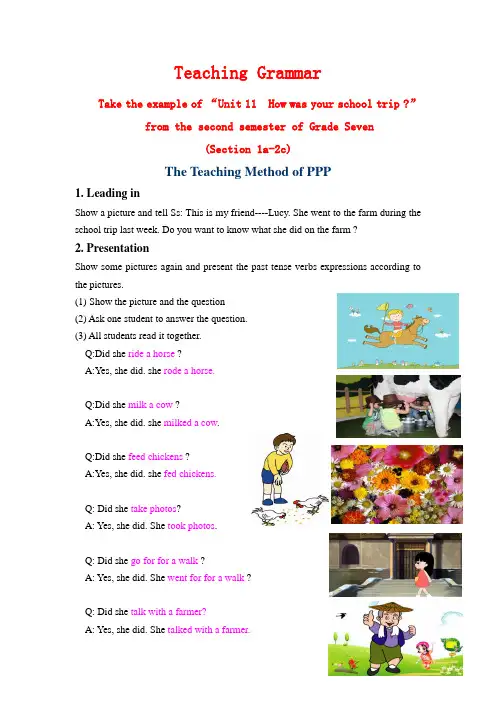
Teaching GrammarTake the example of “Unit 11 How was your school trip ?”from the second semester of Grade Seven(Section 1a-2c)The Teaching Method of PPP1. Leading inShow a picture and tell Ss: This is my friend----Lucy. She went to the farm during the school trip last week. Do you want to know what she did on the farm ?2. PresentationShow some pictures again and present the past tense verbs expressions according to the pictures.(1)Show the picture and the question(2) Ask one student to answer the question.(3) All students read it together.Q:Did she ride a horse ?A:Yes, she did. she rode a horse.Q:Did she milk a cow ?A:Yes, she did. she milked a cow.Q:Did she feed chickens ?A:Yes, she did. she fed chickens.Q: Did she take photos?A: Yes, she did. She took photos.Q: Did she go for for a walk ?A: Yes, she did. She went for for a walk ?Q: Did she talk with a farmer?A: Yes, she did. She talked with a farmer.Q: How was her school trip?A: It was great and interesting.Then the teacher introduce the content of the the simple past tense.过去时态:表示过去某个时间或某一段时间内发生的的动作或存在的状态。
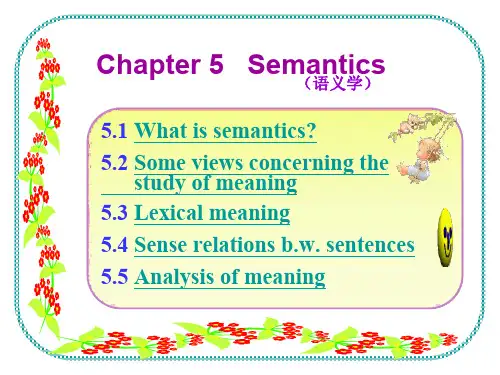
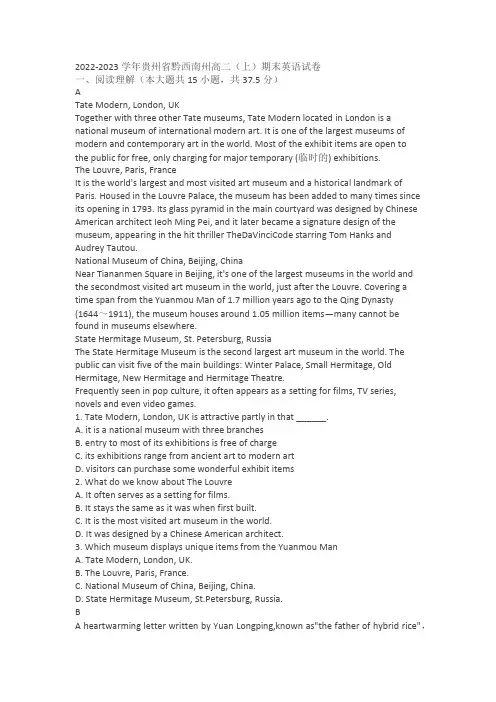
2022-2023学年贵州省黔西南州高二(上)期末英语试卷一、阅读理解(本大题共15小题,共37.5分)ATate Modern, London, UKTogether with three other Tate museums, Tate Modern located in London is a national museum of international modern art. It is one of the largest museums of modern and contemporary art in the world. Most of the exhibit items are open tothe public for free, only charging for major temporary (临时的) exhibitions.The Louvre, Paris, FranceIt is the world's largest and most visited art museum and a historical landmark of Paris. Housed in the Louvre Palace, the museum has been added to many times since its opening in 1793. Its glass pyramid in the main courtyard was designed by Chinese American architect Ieoh Ming Pei, and it later became a signature design of the museum, appearing in the hit thriller TheDaVinciCode starring Tom Hanks and Audrey Tautou.National Museum of China, Beijing, ChinaNear Tiananmen Square in Beijing, it's one of the largest museums in the world and the secondmost visited art museum in the world, just after the Louvre. Covering a time span from the Yuanmou Man of 1.7 million years ago to the Qing Dynasty (1644~1911), the museum houses around 1.05 million items—many cannot be found in museums elsewhere.State Hermitage Museum, St. Petersburg, RussiaThe State Hermitage Museum is the second largest art museum in the world. The public can visit five of the main buildings: Winter Palace, Small Hermitage, Old Hermitage, New Hermitage and Hermitage Theatre.Frequently seen in pop culture, it often appears as a setting for films, TV series, novels and even video games.1. Tate Modern, London, UK is attractive partly in that ______.A. it is a national museum with three branchesB. entry to most of its exhibitions is free of chargeC. its exhibitions range from ancient art to modern artD. visitors can purchase some wonderful exhibit items2. What do we know about The LouvreA. It often serves as a setting for films.B. It stays the same as it was when first built.C. It is the most visited art museum in the world.D. It was designed by a Chinese American architect.3. Which museum displays unique items from the Yuanmou ManA. Tate Modern, London, UK.B. The Louvre, Paris, France.C. National Museum of China, Beijing, China.D. State Hermitage Museum, St.Petersburg, Russia.BA heartwarming letter written by Yuan Longping,known as"the father of hybrid rice",has caught people's eyes as the nation is mourning (悼念)over his passing away.In 2010,at the age 80,Yuan wrote this letter in memory of his late mother,Hua Jing,and many are deeply touched by its sincerity (真情).In the letter,entitled"The Rice is Ripe (成熟),Mom",Yuan recalled the old days with his mother in Anjiang town in Central China's Hunan province,where his mother was buried in 1989.Born in a wealthy family in Yangzhou,eastern China's Jiangsu province,Hua Jing was well educated and open- minded.She taught Yuan English when he was very young.Having never worked in the fields,Hua moved to Anjiang town to support her son's family and research."Mom,the rice is ripe and I come back to Anjiang to see you. ....Every time when I was able to deliver a speech to the audiences from around the world or take a prize in my study,I always thought of you.You made me who I am.People say I've changed the world with one tiny rice seed but mom,I know you sowed (播种)the seed in me when I was a little boy."4. Why did Yuan Longping write a letter in 2010?______A. To honor his mother.B. To attract people's eyes.C. To comfort his mother.D. To public his achievements.5. What moved many people deeply in the letter?______A. The seed.B. The emotion.C. The speech.D. The education.6. What can we know about Hua Jing?______A. She was born in a poor family.B. She used to work in the fields.C. She didn't get any schooling.D. She moved to Anjiang for her son.7. What's the main idea of the last paragraph?______A. The speech to the audience.B. The growth in Anjiang.C. The seed of Yuan's mother.D. The prize in his study.CAre you happy?Do you remember a time when you were happy?Are you seeking happiness today?Many have sought a variety of sources for their feelings of happiness. Some have put their hearts and efforts into their work.Too many have turned to drugs and alcohol.Meanwhile,untold numbers have looked for it in the possession of expensive cars,exotic(异国的)vacation homes and other popular "toys". Most of their efforts have a root in one common fact:people are looking for a lasting source of happiness.Unfortunately,I believe that happiness escapes from many people because they misunderstand the journey of finding it.I have heard many people say that,"I'll be happy when I get my new promotion." Or "I'll be happy when I lose that extra 20 pounds." It is dangerous because it accepts that happiness is a "response" to having,being or doing something.In life,we all experience stimulus(激励)and response.Today,some people think that an expensive car is a stimulus,and happiness is a response;a great paying job is a stimulus,and happiness is a response;a loving relationship is a stimulus,and happiness is a response. This belief leaves us the thinking and feeling:I'll be happywhen …It has been my finding that actually the opposite is true.I believe that happiness is a stimulus and a response is what life brings to those who are truly happy.When we are happy,we tend to have more success in our work.When we are happy,people want to be around us and enjoy loving relationships. When we are happy,we more naturally take better care of our bodies and enjoy good health.Happiness is not a response but a stimulus.Happiness is a conscious choice we make every day of our lives.For unknown reason to me,many choose to be painful,unsuccessful and angry most of thetime.Happiness is not something that happens to us after we get something we want--we usually get things we want AFTER we choose to be happy.8. From the second paragraph,we know too many people ______ .A. are not happy when they work hardB. are not happy when they drink or take drugsC. are happy when they possess their own expensive carsD. all desire exotic vacation homes9. Generally speaking,most people feel happy because ______ .A. they think happiness is rooted in their deep heartsB. they get what they want to haveC. they get a great paying jobD. they get an expensive car10. Which of the following is right according to the author?______A. If you want to get what you want,you first choose to be happy.B. We should try to get more and then we'll be happy.C. Most people today are happy.D. Work is a necessary part in our daily life.11. From the viewpoint of the author,happiness is ______ .A. based on our needsB. unconditionalC. out of reachD. limitedDAs climate change becomes severe summer after summer,millions of people are finding themselves covered in wildfire smoke,including those in North America just this past month.It is bad for our health.It is also really disturbing,but we don't talk about that as much.We often use the terms"atmosphere"or"climate"to refer to the mood of a situation.We use metaphors(比喻)to describe affective states,such as"feeling under the weather"or"on cloud nine".Such language suggests that we understand that human emotions are intimately related to the atmospheric phenomena.Yet rarely do we pay attention to the ways we feel climate change.But wildfire smoke shows how affective climate change can be.For example,wildfire smoke is often referred to using emotional phrases such as"air of dread".Through living with the smoke and the panic it generates,we can think more carefully about the ways we experience climate change,and crucially,why and how we need to respond to it.We often think of climate change impacts as far away,separate from our bodies,because science typically uses global representations and statistical information.But wildfire smoke spreads and pollutes our bodies,and indeed,crosses many other boundaries;it drifts from rural areas into big cities;and it crosses state and national borders with ease.Of course,some borders are more permeable (渗透的),and some bodies more sensitive to the smoke.Through its ability to pass through and become part of our very being,wildfire smoke is closer in nature to the air pollution we normally think of as one of the causes of climate change.Wildfire smoke is both an impact and a cause of climate change.It explains the nature of climate change impacts and the self-reinforcing(自我强化)feedback circles that can,and may,lead to the planet warming itself independent of human actions.12. What can we learn about people's reaction to climate change?______A. They are curious about it.B. They take it very seriously.C. They feel powerless about it.D. They pay little attention to it.13. What does the underlined word"intimately"in paragraph 2 mean?______A. Closely.B. Naturally.C. Certainly.D. Unexpectedly.14. What does the author think of wildfire smoke?______A. It allows people to sense climate change.B. It does little harm to people's health.C. It influences people's mood.D. It attracts scientists' deep concerns worldwide.15. Which of the following can be the best title for the text?______A. Why Smoke from Wildfires Harms UsB. How We Can Observe Climate ChangeC. What Smoke from Wildfires Can Teach UsD. What We Can Do to Avoid Smoke from Wildfires二、阅读七选五(本大题共5小题,共12.5分)阅读下面短文,从短文后的选项中选出可以填入空白处的最佳选项。
觉得自己没有自由英语作文Certainly! Here's your English essay on the topic of feeling like you lack freedom:---。
The Illusion of Constrained Freedom。
Freedom, a concept so intricately woven into the fabric of human existence, often seems elusive. As individuals, we yearn for the autonomy to make choices, to chart our own course in life. However, there are moments when this cherished freedom feels like a distant dream, overshadowed by the constraints imposed upon us by society, circumstance, or even our own minds.At times, the lack of freedom manifests in the mundane routines of daily life. We find ourselves bound by obligations, responsibilities, and societal expectations. From the moment we awaken to the sound of the alarm clock,our day unfolds according to a predetermined script,leaving little room for spontaneity or deviation. The demands of work, family, and social obligations dictate our every move, leaving us feeling like mere actors on a stage, reciting lines written by others.Moreover, societal norms and cultural expectations can serve as invisible shackles, limiting our choices andstifling our individuality. Whether it's the pressure to conform to a certain standard of success, adhere to traditional gender roles, or uphold religious or cultural traditions, we often find ourselves navigating a minefieldof expectations, afraid to stray from the well-trodden path.Yet, perhaps the most insidious form of constraint isthe one we impose upon ourselves. Our fears, insecurities, and self-doubt can become prison walls, confining us to a narrow existence devoid of possibility. We hesitate to pursue our passions, take risks, or speak our minds, paralyzed by the fear of failure or rejection. In doing so, we relinquish the very freedom we so desperately crave, surrendering to the whims of our own inner demons.And yet, amidst the chaos and constraints of life, there exists a glimmer of hope. For true freedom is not merely the absence of external limitations, but the power to transcend them. It is the ability to find autonomywithin ourselves, to cultivate a sense of inner peace and contentment that remains unshaken by the turbulence of the outside world.In the words of Viktor Frankl, "Between stimulus and response there is a space. In that space is our power to choose our response. In our response lies our growth and our freedom." Regardless of the circumstances we find ourselves in, we always retain the power to choose how we perceive and respond to them. We can choose to view obstacles as opportunities for growth, setbacks as stepping stones to success, and constraints as catalysts for creativity.Moreover, true freedom lies in embracing the full spectrum of human experience, including the inevitable struggles and setbacks that accompany it. It is throughadversity that we discover our true strength and resilience, forging a path that is uniquely our own. As the poet Rumiso eloquently wrote, "The wound is the place where theLight enters you." It is through our scars andimperfections that we find the freedom to be authentically ourselves, unburdened by the need for perfection or approval.In conclusion, while it is natural to feel constrained by the myriad forces that shape our lives, true freedom is ultimately a state of mind. It is the ability to transcend external limitations and find autonomy within ourselves. By embracing our inherent power to choose and grow, we can break free from the shackles of circumstance and live alife that is truly our own.---。
克拉申理论主要由以下五个假说组成:1 习得---学得区别假说(The Acquisition —Learning Hypothesis )克拉申理论的出发点和核心是他对习得”和学得”的区分,以及对它们各自在习得者第二语言能力形成过程中所起的作用的认识。
2 监控假说 (The Monitor Hypothesis )监控假说与习得---学得区别假说密切相关,它体现了语言习得”和语言学习”的内在关系。
根据这个假设,语言习得与语言学习的作用各不相同。
语言习得系统,即潜意识语言知识,才是真正的语言能力。
而语言学得系统,即有意识的语言知识,只是在第二语言运用时起监控或编辑作用。
这种监控功能既可能在语言输出(说、写)前也可能在其后。
但是,它能否发挥作用还得依赖于三个先决条件: 1 )有足够的时间,即语言使用者必须要有足够的时间才能有效地选择和运用语法规则;2)注意语言形式,即语言使用者的注意力必须集中在所用语言的形式上,也就是说,必须考虑语言的正确性;3 )知道规则,即语言使用者必须具有所学语言的语法概念及语言规则知识。
在口头表达时,人们一般注意的是说话的内容而不是形式,没有时间去考虑语法规则。
因此,在说话时,如果过多地考虑使用语法监控,不断地纠正自己的语法错误,说起话来就会结结巴巴,妨碍交际进行。
在书面表达时,情况就会好得多,因为作者有足够的时间推敲字句,斟酌语法。
3 输入假说(The In put Hypothesis )输入假说也是克拉申语言习得理论的核心部分。
他曾用一本专著论述他的这个假说。
克拉申认为,只有当习得者接触到可理解的语言输入”(comprehe nsive in put ),即略高于他现有语言技能水平的第二语言输入,而他又能把注意力集中于对意义或对信息的理解而不是对形式的理解时,才能产生习得。
这就是他著名的i + 1公式。
i代表习得者现有的水平,1代表略高于习得者现有水平的语言材料。
根据克拉申的观点,这种i + 1 的输入并不需要人们故意地去提供,只要习得者能理解输入,而他又有足够的量时,就自动地提供了这种输入。
HOMEOSTASIS & BASIC MECHANISMSEmma Jakoi, Ph. D.LEARNING OBJECTIVES1.Identify the tissues, organs, and organ systems that comprise the human body and nametheir functions.2.Identify the fluid compartments of the body and their relative sizes.3.Explain the terms homeostasis, steady state, and equilibrium.4.Define components of a reflex loop.5.Contrast reflex and local homeostatic control6.Explain negative and positive feedbacks.7.Explain tonic and antagonistic controls.8. Explain circadian rhythmsDEFINITION OF PHYSIOLOGYP hysiology is an integrative science that studies the functions of complex living organisms at levels ranging from molecules and cells to organs and systems. Physiologists ask questions of how the specific organ or system works and of what advantage does this system provide. They use this information and that obtained from related fields of anatomy, biochemistry, genetics and immunology to develop a cohesive picture of how organ systems coordinate to maintain life in a constantly changing environment. It is this integrative approach and consideration of coordinated function among organs systems that is a special focus of physiology.Because physiology deals with the integrated behavior of several organ systems in the maintenance of life, it is often considered to be one of the most challenging courses. The objective of this course is that you acquire the terms and concepts of specific areas in physiology but also develop a conceptual framework to analyze data and to predict how one or more organ systems respond to change. Towards this end it is helpful to recognize the recurrent themes or underlying principles (Table 1) as a means for approaching or understanding a new situation.TABLE 1. GENERAL CONCEPTSCell-cell communicationsChemical mass actionControl systemsElastic propertiesGradients and mass flowMass balanceMembrane transport_______________________________TISSUES, ORGANS, SYSTEMS & FLUID COMPARTMENTSDifferentiated cells are cells specialized for a specific function.Tissues are groups of cells which carry out related functions. The four tissue types include: epithelium, muscle, nervous, and connective.Organs are functional units formed by different tissues.Organ systems include several organs that act in an integrated manner to perform a specific function. They provide a means for exchange of materials between the external environment surrounding the body and it’s interior. The ten organ systems of the human body include cardiovascular, respiratory, digestive, endocrine, immune, integument, musculoskeletal, nervous, reproductive, and urinary.The body can be divided into two fluid compartments (Fig 2): ICF and ECF.Intracellular fluid (ICF) is the cytoplasm within cell.Extracellular fluid (ECF) surrounds the cells and serves as a buffer.Figure 2. Fluid compartments of the body.The ECF is divided into the interstitial fluid (ISF) that bathes the outside of the cells and the intravascular fluid(IVF) (i.e., plasma, lymph, and cerebral spinal fluid) (Fig. 2).In the adult 70 kg male, approximately 60% of body weight is water. Under normal conditions, 2/3 of this is ICF and 1/3 is ECF of which ¾ is interstitial fluid and ¼ intravascular fluid. Because most capillaries that separate the ISF and IVF are leaky, the composition of these two compartments is essentially identical. The main difference is that the IVF has higher protein content. However, the composition of the ICF and ECF differ (Table 2, Fig. 2) due to the hydrophobic nature of the cell membrane which prevents free exchange of ions and proteins.ICF is a reducing environment that has a high concentration of K+, but low concentrations of Na+ and free Ca++. Additionally, the concentrations of phosphates and proteins in the ICF are greater than in the ECF (Table 2).ECF is an oxidizing environment that has low concentration of K+but high concentrations of Na+ and free Ca++ (Table 2).TABLE 2. ELECTROLYTES (mM) IN HUMAN CELLSIon ECF (Plasma) ICF (Cytosol) Na+140.0 15.0K+ 4.4 140.0Ca++ 1.2* 0.0005Cl-105.0 7.0* Plasma contains bound as well as free Ca++In most cells, there is a passive leak of K+ across the plasma membrane allowing K+ ions to move from the inside of cells to the outside. This leak is matched by pumping K+ back into the cell via the Na+ -K+ ATPase, an integral membrane protein. The movement (pumping) of K+ back into the cells requires energy (ATP). During each cycle of the ATPase, two K+ are exchanged for 3 Na+ and one molecule of ATP is hydrolyzed to ADP.When K+ is pumped into cells, Na+ is pumped out. This generates an unequal distribution of Na+ and K+ across the plasma membrane which is called a chemical gradient. The unequal distribution of ions also establishes a charge (electro) gradient with the inside of the cell more negative relative to the outside of the cell. The “electrochemical” gradient represents a storehouse of energy (called the electrochemical potential). Sodium ions can enter cells through special protein channels. When Na+ enters, it moves passively down its electrochemical gradient. Its entry is matched by the rate of its removal via the Na+ -K+ ATPase so that the intracellular concentration of Na remains low and constant. The actions of the Na+-K+ ATPase pump balance the amounts of Na+ and K+ entering and leaving the cell per unit time; however, their intracellular and extracellular concentrations are NOT equal. This is called a steady state. Metabolic energy (ATP) is expended to maintain a steady state.EQUILIBRIUM, STEADY STATE & HOMEOSTASISThe keys to maintaining stability of the ECF are self-regulatory mechanisms which allow us to adapt to a changing environment. To understand these adaptations, we need to consider the concepts of equilibrium and steady state.Equilibrium is a condition in which the opposing forces are balanced. There is no net transfer of a substance (or of energy) from one compartment to another. An equilibrium state will occur if there is sufficient time for exchange and if there is no barrier to movement from one compartment to the other. No energy expenditure is required to maintain an equilibrium state.Steady state, is a condition in which the amount (or concentration) of a substance is constant within a compartment and does not change with time. There is no net gain or net loss of a substance in a compartment because the input and output are equal. A steady state is not necessarily an equilibrium state. Energy expenditure may be needed to maintain a steady state.Homeostasis is the maintenance of the ECF as a steady state. When conditions outside of the body change (e.g., temperature), these changes are reflected in the composition of the ECF which surrounds the individual cells of the body. The ECF is the site of exchange where nutrients are delivered and cellular wastes removed. Therefore the composition of the ECF dynamicallychanges with time, but certain factors must be kept within a narrow range for optimal functioning of cells, tissues, and organs. These specific factors include oxygen (O2) and carbon dioxide (CO2), glucose and other metabolites, osmotic pressure, concentrations of H+, Ca++, K+, Mg++, and temperature. Uncorrected deviations can lead to disease and/or death.HOMEOSTATIC REGULATIONTo maintain homeostasis, the functions of various organ systems must be integrated. Both homeostasis and integration require that the cells of the body (~ 75 trillion!) communicate with each other in a rapid and efficient manner. There are two basic types of extrinsic physiological control paths: local and reflex.Local control involves paracrine (between neighbors) and/or autocrine (self-to-self) responses. Proteins called cytokines mediate local control.Reflex control involves the nervous and endocrine systems. Reflex control responds to changes that are more widespread or systemic in nature. In a reflex control pathway (or loop), the decision to respond is made at a distance from the target cell or tissue. Reflex control has three basic components (Fig 3): an input stimulus, integrator of the stimulus, and a response (effector).Figure ponents of a reflex loop.The integrating center evaluates the incoming signal, compares it with a set point (desired value), and decides on an appropriate response. The effector carries out the appropriate response to bring the situation back to within normal limits. Reflex pathways are closed loops.Mass balance in the body refers to a steady state in which the total amount of a substance equals its intake plus its production minus its output.Total body content of X = intake of X + production of X – output of X.Mass flow is mass balance over time, such that:Mass flow (amt/min) = [concentration (amt/vol)] X [volume flow (vol/min)]For example, infusion of 4g of glucose in 10 ml at a rate of 2 ml/min gives a mass flow of:(4g /10 ml) X (2ml/min) = 0.8 g/minThere are several different types of reflex pathways within the body. These include negative feedback, positive feedback, feed forward, tonic control, antagonistic control and circadian rhythms.In Negative feedback loops, the response removes the stimulus (Fig 4). A critical consequence of negative feedback control is that it allows the system to resist deviation of a given parameter from a preset range (or set point). Negative feedback is the most common form of homeostatic control in biological systems.Figure 4.Negative feedback control systems responds to external change that lowers body temperature.In physiological systems, we encounter two types of negative feedback systems (Fig.5): simple (A) and complex (B). The complex negative feedback system permits finer control.Figure 5. Simple and complex negative feedback loops. (A) Simple negative feedback involves two cellular compartments. (B) Complex negative feedback involves more than two cellular components. Typically the feed back signal inhibits secretion at all previous levels.In positive feedback loops, the response reinforces the stimulus rather than decreasing or removing it (Fig. 6) and is therefore an unstable condition. The consequence of positive feedbackis not to maintain homeostasis but to elicit a change. Positive feedback loops are found during development or maturation. They are finite loops; often negative feedback will reduce or terminate these responses.Figure 6. Positive feedback loops. A positive feedback occurs when a hormonesignal increases its stimulation rather than decreasing it.Feed-forward Control enables the body to anticipate a change and start a reflex loop. For example, the sight, smell, or even the thought of food starts our mouths to water. The saliva lubricates the food particles during chewing.Tonic Control permits the activity of the organ system to be modulated (either up or down). This is like the volume control on a radio which enables you to make the sound louder or softer by turning a single knob. For example, the diameter of a blood vessel is set by the activity of the sympathetic nervous system (Fig. 7). A moderate rate of signaling from the nerve results in a blood vessel of intermediate diameter. An increase in the rate of signaling by the nerve results in constriction of the vessel; a decrease in signaling leads to dilation.Figure 7.Tonic control. Physiological parameters that are under tonic control are regulatedby modulation (up-down) rather than by on-off switches. Tonic control is an important regulator of blood flow to the organs.Antagonistic Control modulates the activity of an organ system by two separate regulators which act in opposition. For example (Fig. 8), chemical signals (neurotransmitter) from a sympathetic neuron increase heart rate, whereas neurotransmitters from a parasympathetic neuron decrease it.Figure 8. Antagonistic control of heart rate.Circadian Rhythms allow control systems to fluctuate in a predictable, timed manner over a 24 hour cycle as their set points change. Circadian rhythms govern many biological functions, including blood pressure, body temperature, and metabolic processes. Circadian rhythms arise from special group of cells in the brain (hypothalamus) which are programmed by either the light-dark, day-night cycle by input from the retina or our sleep (rest) -activity periods. When the circadian clock is altered (e.g., jet lag), temperature rhythms and the secretion of various hormones are also altered.KEY CONCEPTThe human body is an inter-dependent set of self-regulating systems whose primary function is to maintain an internal environment compatible with living cells and tissues (homeostasis). Important Generalizations of Homeostatic Control Systems•Stability of internal variables is achieved by balancing inputs and outputs to the body and among organ systems.•In negative feedback systems, a change in a variable is corrected by bringing the body back to the initial set point. Note that set points can be “reset” at a higher or lower physiological value.•Not always possible to maintain everything relatively constant by homeostatic control mechanisms in response to change. There is a hierarchy of importance in the maintenance of life.Problem:Identify the components of the reflex loop in the following scenario.You have finished the marathon in just under three hours. You are tired, sweating profusely, and start to drink Gatorade. After a few minutes you are still tired but no longer sweating or thirsty. Answer:Sweating = loss of ECF water (stimulus); the stimulus is recognized by the hypothalamus (integrator); the thirst response (effector) is triggered; the individual drinks Gatorade; this removes the stimulus; i.e., no longer thirsty; this is classic negative feedback。
Go/no-go任务中的西蒙效应现象-教育心理学论文Go/no-go任务中的西蒙效应现象雒淼淼(辽宁师范大学脑与认知神经科学研究中心,大连,116029)摘要:西蒙效应是指被试在做按键反应时,即使刺激位置和反应位置与任务无关,但刺激位置和反应位置出现在同侧比出现在不同侧时反应更快更准确的现象。
西蒙效应的反转就是对在不一侧的反应反而快于同一侧的反应。
研究发现,在执行西蒙任务之前练习一个不同侧的空间联结,西蒙效应就会消失,甚至发生了西蒙效应的反转现象。
之后的研究发现,go/no-go相容性任务中也能调制出来西蒙效应,进一步讨论西蒙效应的理论基础。
西蒙效应在人类生活中的应用。
关键词:西蒙效应Go/no-go 相容性任务作者简介:雒淼淼,女,辽宁师范大学脑与认知神经科学研究中心,硕士。
前言西蒙效应是在1963年Simon和Wolf在一次实验中发现的。
1967年,Simon 和Rudell做了第一个意义上的西蒙效应的实验,他们随机给被试的左耳和右耳呈现“左”、“右”这两个词,被试根据词的意义按左键或者右键,词出现在左耳或右耳都是随机并且是和任务无关的,但即使与任务无关,声音出现空间位置对应比不对应的反应快一些。
比如,在左耳出现“左”比在右耳出现“左”的反应快。
Simon等首先揭示了刺激出现的空间位置与反应速度的这种关系,并且把这种效应命名为西蒙效应。
在一个任务中,要求被试当屏幕出现红色方块时按左键,出现绿色方块时按右键,忽略方块出现的位置,这被定义为一个标准的西蒙任务(HedgeMarsh, 1975),方块刺激出现的位置和反应按键的位置对应时比他们空间位置不对应时的反应更快且准确率更高。
比如,当红色方块出现在屏幕左侧时,被试做出的反应要快于红色方块出现在右侧的情况,出现了西蒙效应(RubichiNicoletti,2006;Rubichi,Nicoletti,Iani,Umilta,1997;Rubichi,Nicolett i,Pelosi,Umiltà,2004;SimonRudell,1967;ProctorVu,2006;Rubichi,Vu,Nicole tti,Proc-tor,2006)。
Writing Testbenches using SystemVerilog197CHAPTER 5STIMULUS AND RESPONSEThe purpose of writing testbenches is to apply stimulus to a designand observe the response. That response must then be comparedagainst the expected behavior.
Generating stimulus is the process of providing input signals to thedesign under verification as shown in Figure5-1.From the perspec-tive of the stimulus generator, every input of the design is an outputof the generator.
Monitoring is the process of observing output signals from thedesign under verification as shown in Figure5-2.From the perspec-tive of the response monitor, every output of the design is an inputof the monitor.
Figure 5-1.Stimulus generation
DesignunderVerification
Stimulus
Generation
Figure 5-2.Responsemonitoring
Response
Monitoring
Design
underVerificationStimulus and Response198Writing Testbenches using SystemVerilogThis chapter shows how to apply stimulus and observe response.
In this chapter, I show how to generate stimulus and observeresponses. I also show how to abstract data flowing to and from thedesign from a physical level composed of 1’s, 0’s and elapsed timeto a transaction level composed of data objects and procedures. Thegreatest challenge with stimulus is making sure it is an accuraterepresentation of the environment, not just a simple case. Whenmonitoring responses, one has to be careful not to miss any data anddetect as many errors as possible.
The next chapter shows how to structure a test-bench.
In the next chapter, I show how to best structure the stimulus gener-ators and response monitors to create a layered self-checking envi-ronment. Constrainable random generation is then added on top ofthe stimulus generators and response monitors. If you prefer a top-down perspective, I recommend you start with the next chapter thencome back to this one.
REFERENCE SIGNALSClock signals must be gener-ated with care.
Because a clock signal has a very simple repetitive pattern, it is oneof the first and most fundamental signals to generate. It is also themost critical signal to generate accurately. Many other signals useclock signals to synchronize themselves.
Use a module thread.Generate the clock signals using a module thread. Program threads
are designed to be reactive to the events occurring in the design.Clock signals are the primary cause of these events. The designreacts to clock events. The always blocks generating the clock sig-nals should be inside a module, as shown in Sample 5-1.
Explicitly ini-tialize the clock variable.
The code to generate a 50 percent duty-cycle 100MHz clock signalis shown in Sample 5-1. Using a statement like clk = ~clkdepends on the proper initialization of the clock signal to a valuedifferent than the default value of 1'bx. Initializing the clock vari-ables using an explicit initializer value also prevents the generationof clock events at time zero, potentially creating initialization raceconditions, as described in “Initialization Races” on page182.
Sample 5-1.Generating a 50% duty-cycle clock
module tb_top;bit clk = 0;always #5 clk = ~clk;...endmoduleReference SignalsWriting Testbenches using SystemVerilog199Any repetitive waveform is easy to generate.
Waveforms with deterministic edge-to-edge relationships with aneasily identifiable period also are easy to generate. It is a simpleprocess of generating each edge in sequence, at the appropriatetime. For example, Figure5-3 outlines an apparently complexwaveform. However, Sample 5-2 shows that it is simple to gener-ate.
Time Resolution IssuesInteger division may speed-up the clock.
When generating waveforms in SystemVerilog, you must select theappropriate timescale and precision to properly place the edges atthe correct offset in time. When using an expression, such ascycle/2, to compute delays, you must make sure that integeroperations do not truncate a fractional part. For example, the clockgenerated in Sample 5-3 produces a period of 14 nanosecondsbecause of truncation caused by the integer division.
The time-scale may affect the timing of edges.
If the precision of the currently active timescale is not sufficientlyhigh, delay values are rounded up or down. When this happens tothe delay values of clock signals, it shifts the relative position of theclock edges. For example, the clock generated in Sample 5-4 pro-
Figure 5-3.Apparentlycomplexwaveform
Sample 5-2.Generating a deterministicwaveform
alwaysbegin S = 1’b0; #20ns; S = 1’b1; #10ns; S = 1’b0; #10ns; S = 1’b1; #20ns; S = 1’b0; #50ns; S = 1’b1; #10ns; S = 1’b0; #20ns; S = 1’b1; #10ns; S = 1’b0; #20ns; S = 1’b1; #40ns; S = 1’b0; #20ns; ...end